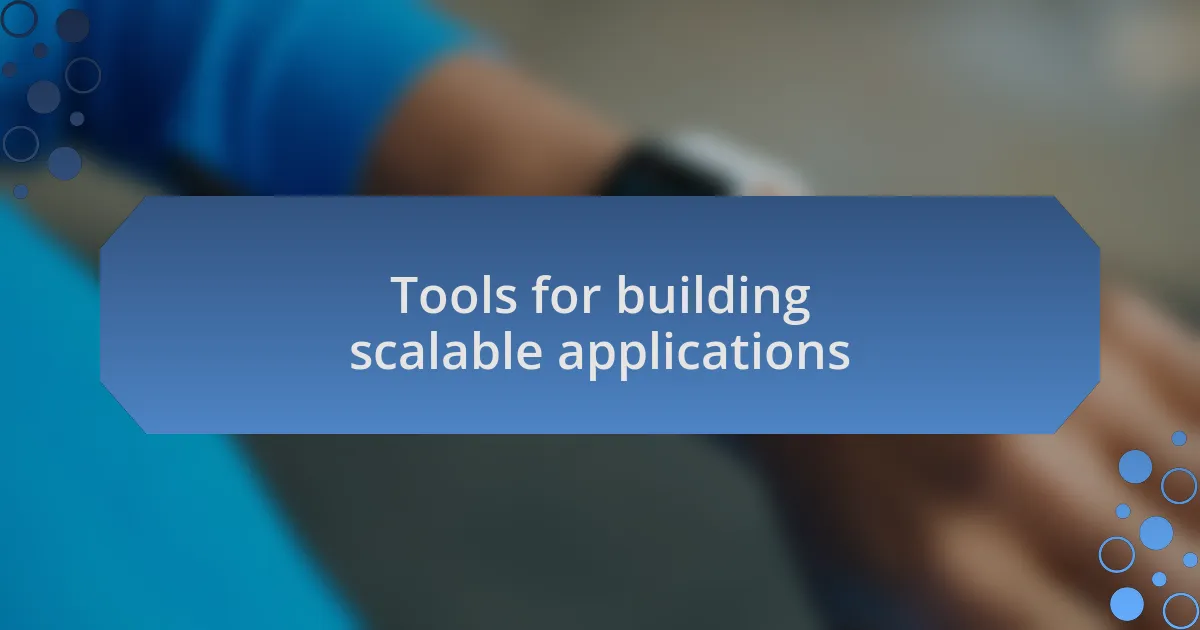Key takeaways:
- Scalability is crucial for applications to handle increasing loads without performance issues; it requires careful architectural planning from the start.
- Modular design, load balancing, and asynchronous processing are key principles for creating scalable applications that enhance flexibility and user experience.
- Tools like cloud platforms, Docker, and performance monitoring solutions are essential for building and maintaining scalable applications effectively.
- Investing in scalable solutions upfront can lead to significant long-term savings and improved user satisfaction.

Understanding scalable applications
When I first started building applications, the concept of scalability felt daunting. I realized scalability refers to an application’s ability to handle increasing loads—whether it’s more users, transactions, or data—without sacrificing performance. I mean, no one wants to create something that crashes under pressure, right?
In my experience, one of the most critical aspects of scalability is architecture. Choosing the right framework and design from the get-go is essential. I recall a project where we rushed into development without considering future growth, which taught me the hard way the importance of a modular approach. Have you ever felt stuck because your initial decisions limited you down the road? I certainly have.
Furthermore, scalability isn’t just a technical challenge; it can evoke some serious emotions. I still remember the anxiety during a product launch, wondering if we’d be prepared for a sudden influx of users. Creating a scalable application isn’t merely about code; it’s about peace of mind. I encourage you to think ahead and embrace strategies like cloud services and load balancing early on. What’s the point of building something incredible if it can’t withstand the test of time?

Importance of scalability in software
When I think about scalability, I immediately recognize it as the backbone of a successful application. I’ve seen too many projects fail because their founders underestimated the need for growth. Have you ever fretted over a sudden spike in traffic? It’s a nail-biting experience when you realize your app might not handle it, leading to frustrated users and lost opportunities.
In one of my earlier projects, our user base exploded overnight following a successful marketing campaign. I remember the panic as we scrambled to upgrade our servers while users faced slow load times. That situation taught me that anticipating growth is just as crucial as having a sleek interface. Scalability isn’t merely a technical feature; it’s about building a solid foundation that promotes user trust and satisfaction.
Moreover, consider how scalability affects long-term costs. I learned that investing in scalable solutions upfront saves money down the line, as frequent overhauls can get pricey. It’s a bit like choosing to invest in quality ingredients for your favorite recipe: you might spend a little more now, but the results are worth it. How much are you willing to sacrifice today for the sake of future success? Ultimately, scalability can be a significant differentiator in a landscape filled with fleeting trends.

Key principles of scalable design
When designing scalable applications, one of the crucial principles to consider is modularity. I’ve found that breaking down my application into smaller, manageable components allows for more flexibility and easier upgrades. Have you ever tried to make a change in a monolithic application? It can feel like trying to change a tire on a moving car. With a modular approach, each component can evolve independently, simplifying both testing and deployment.
Another key principle is the importance of load balancing. I vividly recall a challenging moment when my application experienced a surge in user activity due to a trending event. Instead of a disastrous crash, we maintained performance by efficiently distributing requests across multiple servers. It’s like a restaurant during peak hours, where the host assigns tables to waitstaff to ensure every customer receives prompt service. How prepared is your architecture to handle the busiest of nights?
Lastly, embracing asynchronous processing has been a game-changer for me. I remember building a feature that required lengthy computations. At first, users would wait and watch a progress bar—frustrating for everyone involved. By implementing asynchronous tasks, I was able to free up the user interface, allowing users to explore other parts of the app without the dreaded wait. This principle not only enhances the user experience but also optimizes resource use—something no developer should overlook. How can you integrate more asynchronous processes to elevate your app’s efficiency?

Tools for building scalable applications
When it comes to tools for building scalable applications, I have found that cloud platforms like AWS and Azure are indispensable. I’ve personally witnessed how their auto-scaling features can seamlessly accommodate surges in traffic, allowing my applications to run smoothly without any manual intervention. Have you ever enjoyed the comfort of knowing your application can effortlessly grow alongside your user base? It’s a game-changer.
Another valuable tool in my arsenal is Docker. I recall a project where containerization made a significant difference in deployment efficiency. By packaging my application with all its dependencies, I could ensure that it ran consistently across different environments. It’s like having a reliable meal kit that simplifies the cooking process—everything you need is right there. How much easier could your life become by incorporating such tools into your workflow?
Finally, I can’t emphasize enough the importance of monitoring tools like New Relic or Datadog. Early in my journey, I overlooked the necessity of tracking performance metrics, only to realize that without them, I was flying blind. Once I implemented these monitoring solutions, I gained insights that directly influenced optimizations, leading to a significantly enhanced user experience. What kind of performance indicators could reshape the way you approach scalability?

My personal approach to scalability
When I think about scalability, I focus heavily on modular architecture. During one of my earlier projects, I made the mistake of tightly coupling components, and I felt the pressure when it was time to scale. I learned that by breaking down my application into smaller, independent modules, I could enhance both performance and adaptability. Have you ever felt stuck trying to make a big change to a monolithic structure? That freedom to evolve is incredibly empowering.
Another aspect I prioritize is efficient database management. I remember a time when I had to troubleshoot slow queries that plagued the user experience. By optimizing those queries and transitioning to a NoSQL database for specific use cases, I noticed a remarkable improvement in response times. Reflecting on that moment, I realized how critical database choice is to scalability. Have you considered how your data structure impacts your application’s growth potential?
Lastly, I embrace continuous integration and continuous deployment (CI/CD) pipelines in my process. I once encountered a frustrating delay during a release due to unforeseen bugs, which underscored the value of a robust pipeline. By automating testing and deployment, I significantly reduced the chances of hiccups during launches. Isn’t it reassuring to know that your updates can roll out smoothly, enhancing both reliability and speed?